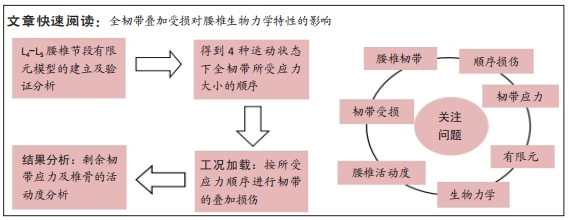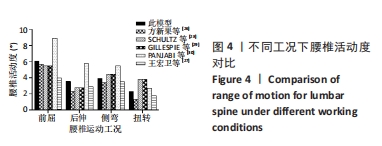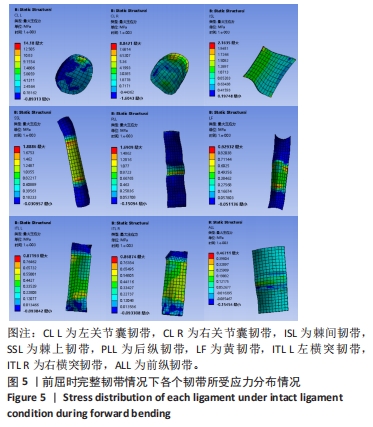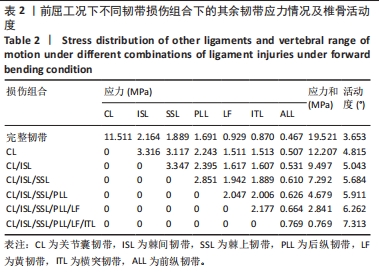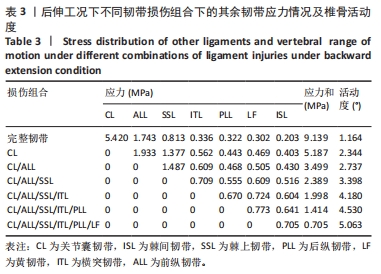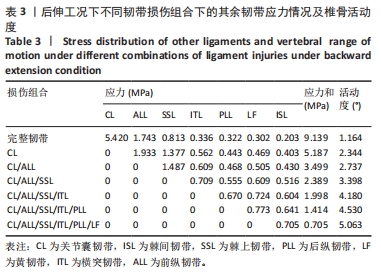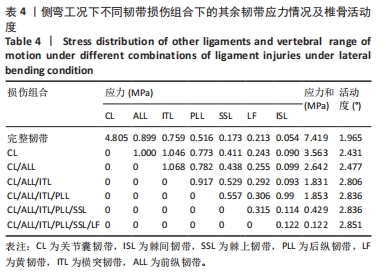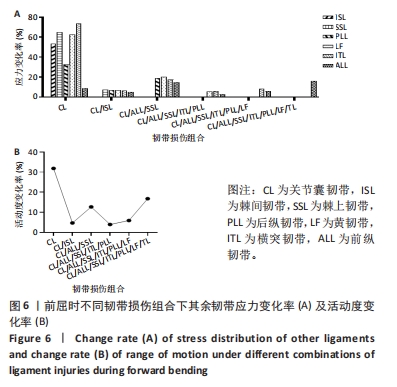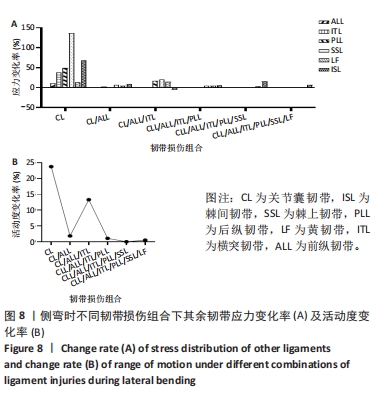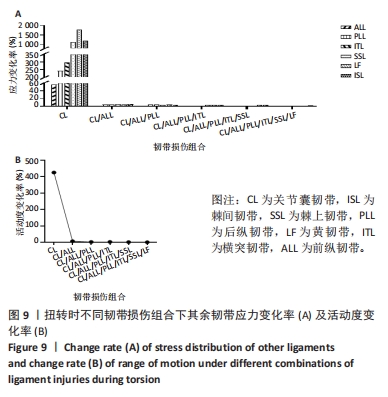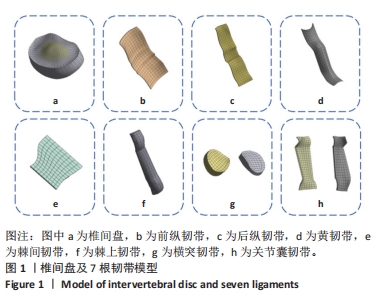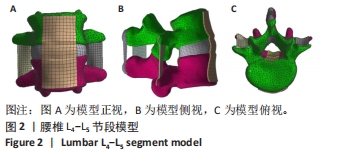[1] 文毅,苏峰,刘肃,等.L_(4-5)椎体有限元模型建立及退变椎间盘力学分析[J].中国组织工程研究,2019,23(8):1222-1227.
[2] 徐玉东,王建红.人体解剖生理学[M].北京:人民卫生出版社, 2007:31-34.
[3] 孙祥耀,鲁世保,张庆明,等.腰椎退行性疾病手术治疗的有限元建模研究进展及相关问题的述评[J].中国骨与关节杂志,2023, 12(4):241-247.
[4] PANJABI MM, WHITE AA 3RD. Basic biomechanics of the spine. Neurosurgery. 1980;7(1):76-93.
[5] 柏树令.系统解剖学[M].7版.北京:人民卫生出版社,2008.
[6] HUISKES R,CHAO EYS,胡家栋.骨科生物力学有限元分析头10年工作综述[J].力学进展,1986(1):98-34.
[7] 赵崇程.基于“筋骨并重”理论的脊柱内镜下切除部分腰椎后纵韧带的有限元研究[D].石家庄:河北中医学院,2021.
[8] PIZONES J, IZQUIERDO E, SANCHEZ-MARISCAL F, et al. Sequential damage assessment of the different components of the posterior ligamentous complex after magnetic resonance imaging interpretation: prospective study 74 traumatic fractures. Spine. 2012;37:E662-E667.
[9] RIHN JA, YANG N, FISHER C, et al. Using magnetic resonance imaging to accurately assess injury to the posterior ligamentous complex of the spine: a prospective comparison of the surgeon and radiologist. J Neurosurg Spine. 2010;12:391-396.
[10] LI Y, SHEN Z, HUANG M, et al. Stepwise resection of the posterior ligamentous complex for stability of a thoracolumbar compression fracture: An in vitro biomechanical investigation. Medicine. 2017;96: e7873.
[11] 吴聪聪.胸腰段脊柱后方韧带复合体序贯损伤对其稳定性的有限元分析[D].温州:温州医科大学,2019.
[12] PINTAR FA, YOGANANDAN N, MYERS T. Biomechanical properties of human lumbar spine ligaments. J Biomech. 1992;25(11):1351-1356.
[13] GUO LX, LI WJ. A biomechanical investigation of thoracolumbar burst fracture under vertical impact loads using finite element method. Clin Biomech. 2019;68:29-36.
[14] 黎珂宇.基于有限元法的人体腰椎力学分析及其应用研究[D].南京:南京航空航天大学,2019.
[15] 李民,周灵,汪桂珍,等.不同腰椎生理曲度下牵引的三维有限元分析[J].中国组织工程研究,2020,24(20):3162-3167.
[16] CHOSA E, TOTORIBE K, TAJIMA N. A biomechanical study of lumbar spondylolysis based on a three-dimensional finite element method. J Orthop Res. 2004;22(1):158-163.
[17] EZQUERRO F, SIMÓN A, PRADO M, et al. Combination of finite element modeling and optimization for the study of lumbar spine biomechanics considering the 3D thorax–pelvis orientation. Med Eng Phys. 2004; 26(1):11-22.
[18] GOTO K, TAJIMA N, CHOSA E, et al. Mechanical analysis of the lumbar vertebrae in a three-dimensional finite element method model in which intradiscal pressure in the nucleus pulposus was used to establish the model. J Orthop Sci. 2002;7(2):243-246.
[19] 张文,王兰,施勤,等.腰椎行椎间孔入路椎间融合术固定的有限元分析[J].医用生物力学,2014,29(5):405-410.
[20] RASTEGAR S, ARNOUX PJ, WANG XY, et al. Biomechanical analysis of segmental lumbar lordosis and risk of cage subsidence with different cage heights and alternative placements in transforaminal lumbar interbody fusion. Comput Methods Biomech Biomed Engin. 2020;23(9):456-466.
[21] 苏晋,赵文志,陈秉智,等.建立全腰椎有限元接触模型[J].医用生物力学,2010,25(3):200-205.
[22] 刘治华,徐新伟,管文浩,等.腰椎有限元模型的建立与不同角度牵引条件下的仿真研究[J]. 郑州大学学报(医学版),2014(1): 119-122.
[23] YOGANANDAN N, KUMARESAN S, VOO L, et al. Finite element applications in human cervical spine modeling. Spine. 1996;21(15):1824-1834.
[24] QIN Y, ZHAO B, YUAN J, et al. Does Cage Position Affect the Risk of Cage Subsidence After Oblique Lumbar Interbody Fusion in the Osteoporotic Lumbar Spine: A Finite Element Analysis. World Neurosurg. 2022;161: e220-e228.
[25] 颜文涛,赵改平,方新果,等.人体腰椎L_(4~5)节段有限元建模及分析[J].生物医学工程学杂志,2014,31(3):612-618.
[26] 方新果,赵改平,王晨曦,等.基于CT图像腰椎L4~L5节段有限元模型建立与分析[J].中国生物医学工程学报,2014,33(4):487-492.
[27] 王宏卫,刘新宇,万熠.人体腰椎L_4-L_5段有限元模型建立及力学有效性验证[J].医学与哲学(B),2017,38(5):50-53.
[28] SCHULTZ AB, WARWICK DN, BERKSON MH, et al. Mechanical properties of human lumbar spine motion segments part 1: responses in flexion, extension, lateral bending, and torsion. J Biomech Eng. 1979;101:46-52.
[29] GILLESPIE KA, DICKEY JP. Biomechanical role of lumbar spine ligaments in flexion and extension: Determination using a parallel linkage robot and a porcine model. Spine. 2004;29(11):1208-1216.
[30] PANJABI MM, GOEL VK, TAKATA K. Physiologic strains in the lumbar spinal ligaments. An in vitro biomechanical study 1981 Volvo Award in Biomechanics. Spine. 1982;7(3):192-203.
[31] 高素荷. 网格划分密度与有限元求解精度研究[C].//第十五届全国机械设计年会论文集. 2010:161-163,168.
[32] ASANO S, KANEDA K, UMEHARA S, et al. The mechanical properties of the human L4-5 functional spinal unit during cyclic loading. The structural effects of the posterior elements. Spine. 1992;17(11):1343-1352.
[33] WIDMER J, CORNAZ F, SCHEIBLER G, et al. Biomechanical contribution of spinal structures to stability of the lumbar spine-novel biomechanical insights. Spine J. 2020;20(10):1705-1716.
[34] HEUER F, SCHMIDT H, KLEZL Z, et al. Stepwise reduction of functional spinal structures increase range of motion and change lordosis angle. J Biomech. 2007;40:271-280.
[35] 李银倩,吕杰,王多多,等.三维有限元法分析前纵韧带对腰椎生物力学的影响[J].生物医学工程学进展,2023,44(2):176-183.
[36] ELLINGSON AM, SHAW MN, GIAMBINI H, et al. Comparative role of disc degeneration and ligament failure on functional mechanics of the lumbar spine. Comput Methods Biomech Biomed Engin. 2016; 19(9/12):1009-1018.
[37] KUGA N, KAWABUCHI M. Histology of intervertebral disc protrusion: an experimental study using an aged rat model. Spine. 2001;26(17):379-384.
[38] FUNG YC. Biorheology of soft tissues. Biorheology. 1973;10(2):139-155.
[39] SHIN JH, WANG S, YAO Q, et al. Investigation of coupled bending of the lumbar spine during dynamic axial rotation of the body. Eur Spine J. 2013; 22(12):2671-2677.
[40] 高旭,邢文华.有限元分析法在脊柱外科领域的应用[J].中国组织工程研究,2023,27(18):2921-2927.
[41] ZHANG Q, CHON T, ZHANG Y, et al. Finite element analysis of the lumbar spine in adolescent idiopathic scoliosis subjected to different loads. Comput Biol Med. 2021;136:104745.
[42] DUPUIS S, FORTIN C, CAOUETTE C, et al. Global postural re-education in pediatric idiopathic scoliosis: a biomechanical modeling and analysis of curve reduction during active and assisted self-correction. BMC Musculoskelet Disord. 2018;19(1):200.
|
